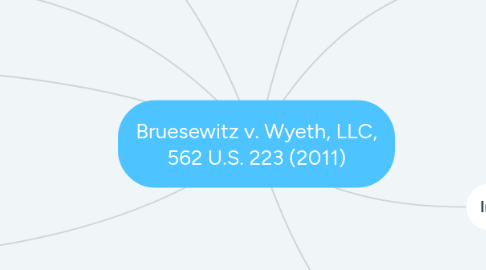
1. Facts
1.1. Parties
1.1.1. Plaintiff
1.1.1.1. Russel Bruesewitz et al
1.1.1.1.1. Russel and Robalee have a daughter named Hannah
1.1.2. Defendant
1.1.2.1. Wyeth
1.1.2.1.1. Vaccine created by Lederle Laboratories
1.2. What Happened
1.2.1. In 1986 the National Childhood Vaccine Injury Act (from now on referred to as "the Act") created a program to compensate those injured by vaccines, without blame, and to basically save the manufacturers who had seen a huge increase in lawsuits
1.2.1.1. This stabilizes market, protects manufacturers, and victims still receive payouts funded by a tax placed on vaccines
1.2.2. In 1992 when Hannah was 6 months old, she was given the diphtheria, tetanus, and pertussis vaccine
1.2.2.1. 2 hours later she developed seizures and was hospitalized
1.2.2.1.1. She permanently has residual seizure disorder and developmental delay
1.2.3. In 1998 this vaccine was removed from market
1.3. Procedural History
1.3.1. In 1995, the parents filed a petition (to the compensation program under the Act)
1.3.1.1. One month before, Hannah's specific disorder had been removed from a list of applicable injuries
1.3.1.2. Petition was denied
1.3.1.2.1. though they were still awarded $126,800 in attorney's fees and costs
1.3.2. Parents rejected the judgment and filed lawsuit with state court in Pennsylvania
1.3.2.1. Wyeth moved suit to district court
1.3.2.1.1. Federal judge dismissed
1.3.3. In 2011 the US Court of Appeals affirmed
2. Issue
2.1. Can the National Childhood Vaccine Injury Act protect vaccine manufacturers from liabilities?
2.1.1. Does this federal Act supersede state law regarding product liability claims?
3. Rule of Law
3.1. National Childhood Vaccine Injury Act
3.1.1. Compensation program replaces lawsuits
3.1.2. Protects vaccine manufacturers when guidelines are followed
3.1.2.1. Not liable "if the injury or death resulted from side effects that were unavoidable even though the vaccine was properly prepared and was accompanied by proper directions and warnings"
3.2. Strict Product Liability
3.2.1. Regardless of reasonable care or intentions, or eve contractual relationship
3.2.2. Must prove:
3.2.2.1. Product was unreasonably dangerous
3.2.2.2. Product did not change between being manufactured and administered
3.2.2.2.1. i.e. nobody changed the vaccine; the product had a problem when it was created
3.2.2.3. Product caused injury
3.2.2.4. For design defects...
3.2.2.4.1. There must have been a reasonable alternative
3.2.2.4.2. Manufacturer's decision to not use alternative caused the product to be unreasonably dangerous
4. Analysis/Application
4.1. Plaintiff
4.1.1. Design defect due to foreseeable risk when product was used as intended
4.1.1.1. Leberlee knew for over 25 years that acellular vaccine was safer
4.1.2. Doctor was not warned
4.1.2.1. Doctor said she would not have administered if she had known the lot was associated with multiple deaths and injuries
4.2. Defendant
4.2.1. The Act protects them from civil action because vaccine had proper directions and was appropriately prepared
4.2.1.1. The vaccine tax funds the compensation program for these exact cases
4.2.1.2. Even 1 manufacturer leaving the market would likely cause vaccine shortages
4.2.1.3. They don't have to warn doctor, just injured party or their legal representative
4.3. Court
4.3.1. The Act prevents claims in order to protect drug manufacturers
4.3.1.1. Without this protection, there would be no reason for a company to risk lawsuits by producing a vaccine
4.3.1.1.1. Especially since then the tax has no point
4.3.1.2. Cannot question design of vaccine
4.3.1.2.1. side effects could always be avoided if a different vaccine was used
4.3.1.2.2. The Act specifies only manufacture and warnings, so design liability is left out
4.3.1.3. "unavoidable"
4.3.1.3.1. Design is given, otherwise all side effects would be avoidable
4.3.1.3.2. So you have to show that given this design, the side effects were still avoidable
4.3.1.4. Design Defects
4.3.1.4.1. Not mentioned in the Act deliberately because they are not a basis for liability
5. Conclusion
5.1. Yes, the Act protects vaccine manufacturers from liability by setting up the compensation program to replace lawsuits
5.1.1. And yes, this Act supersedes state liability laws
6. Impact
6.1. Milik v. Secretary of Health and Human Services, 822 F. 3d 1367 (2016)
6.1.1. Son allegedly disabled due to MMR vaccine
6.1.2. Said Bruesewitz v. Wyeth was unconstitutional and does not prevent them from filing claim
6.1.2.1. court disagreed
6.2. Holmes v. Merck, 697 F. 3d 1080 (2012)
6.2.1. Child died 6 months after receiving MMR vaccine
6.2.2. very similar to the Bruesewitz case - waited for it to conclude before making decision
6.2.2.1. it applied, so therefore the manufacturer was protected
7. Importance
7.1. Drug manufacturers are basically safe!
7.1.1. The Act has a lot of protections, so they can feel safer to make these vaccines without exposure to significant liability
7.2. Plaintiffs will have a very difficult time claiming design defects
7.2.1. Another method, or even a better method, could almost always be used. Argument needs to go further to show previous knowledge, cost, chance of injury, etc.
7.3. Federal law preempts state law
7.3.1. Must consider all of it and be aware of federal laws and how they will interact with state laws

